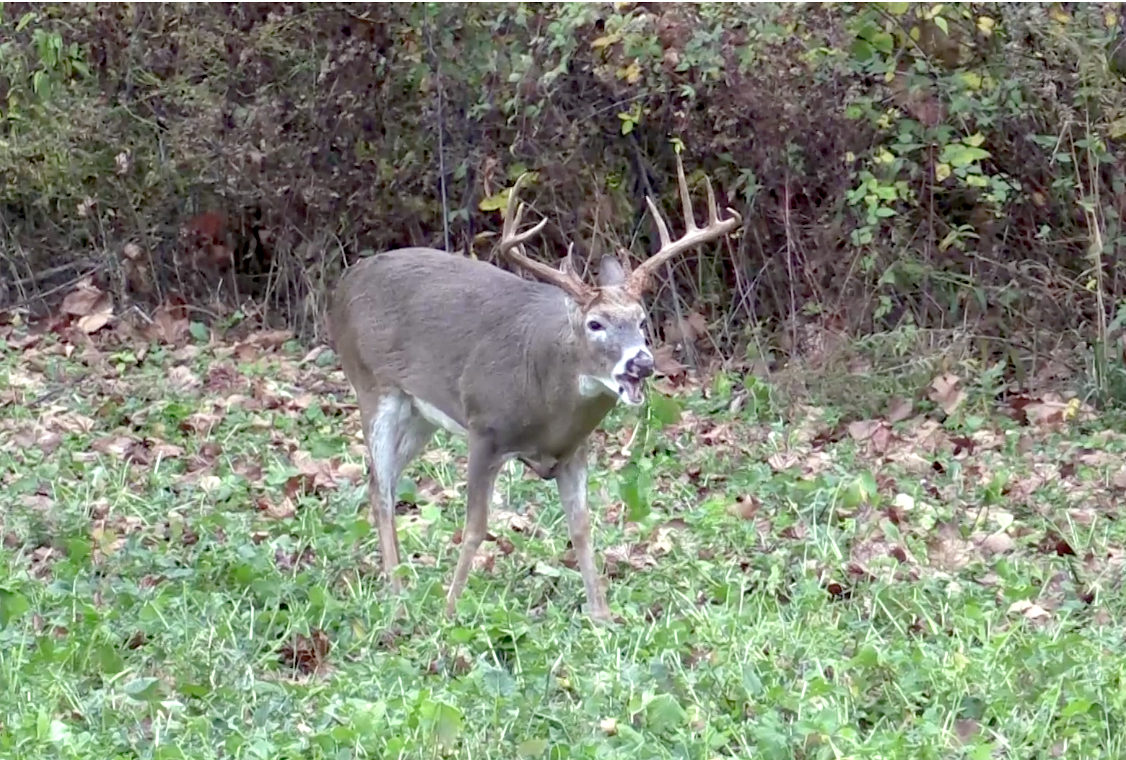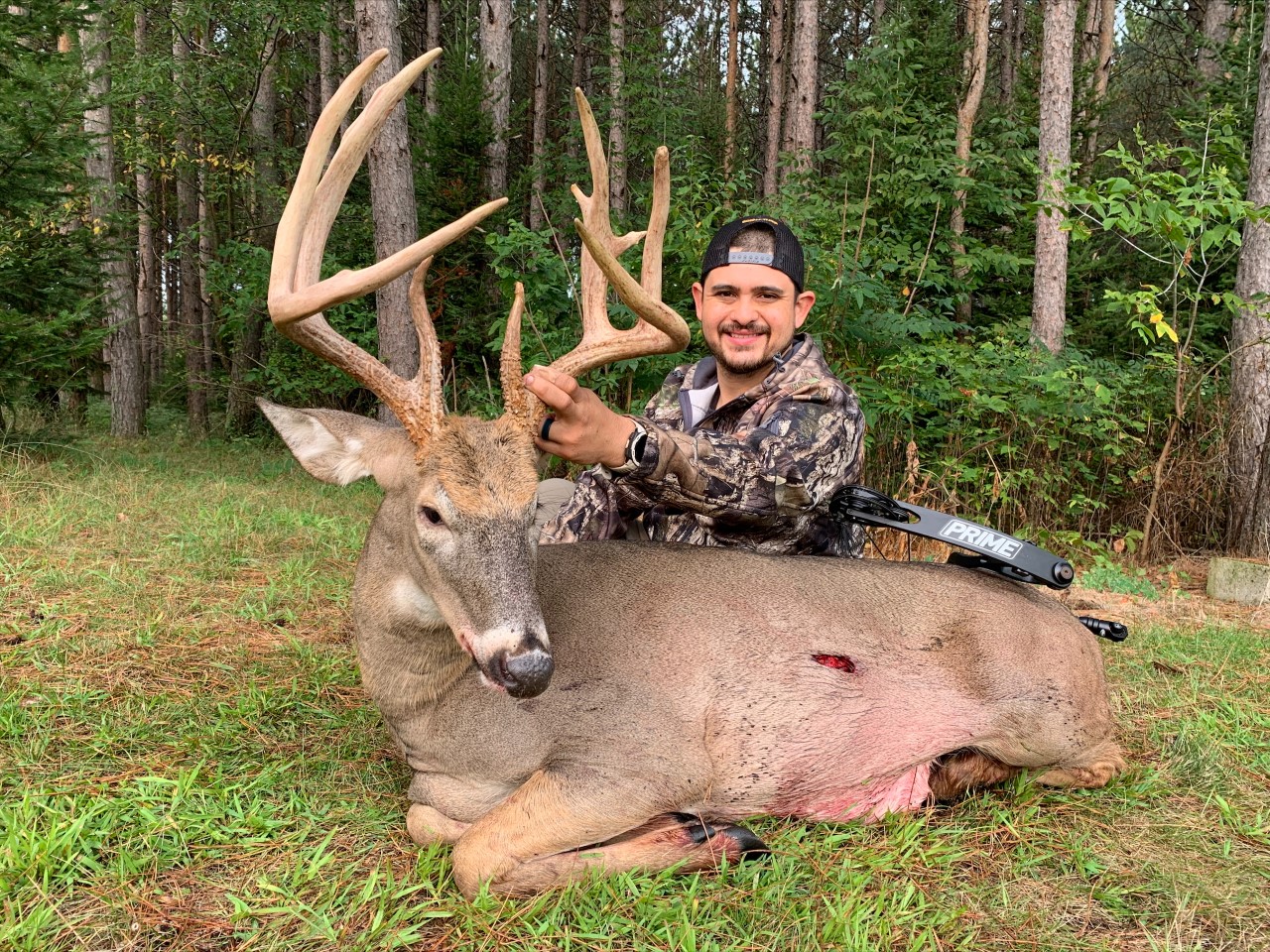Many hunters don’t have access to large tracts of private land. Leases can be too expensive for the average hunter, and the ability to gain landowner permission has declined sharply the past few decades.
Being successful on small tracts, hidden woodlots and even backyards is more relevant now than ever, and it’s possible with the right plan and a few critical factors.
But does your small tract, with obvious limitations, have the ability to produce a quality whitetail? The answer might surprise you.
The 6.5 Plan
I bought my house in Spring 2019 with the goal of having some land and possibly a small place to hunt. I was hoping for about 10 acres of woods surrounded by fields and other ideal whitetail habitat. I signed papers on 6.5 acres, only 2 to 3 acres of which were potential whitetail cover, as the lot is surrounded by three other houses.
There were few trees on the property, but thick briars, autumn olive and a goldenrod field comprised most of the huntable area. Signs of old rubs and a few dried tracks indicated that deer at least passed through the backcside of my property, and a raised hunting blind with an old, weed-choked food plot showed some potential. It was just 60 yards behind the pole barn and 100 yards from the back porch of my house, so I had work to do. The silver lining, however, were the surrounding ag fields and 40 acres of untouched whitetail bedding area directly behind my yard.
In 2019, I tilled two large portions of my backyard grass near my fence line in an attempt to expand the area deer would use and feel safe on at my property. I spent days spraying Roundup and tilling the yard plots and overgrown food plot by the blind until they were finally ready to plant. In both plots, I planted a mix of beans, winter peas, clover and oats sure to make any whitetail salivate. Soon, however, the record rains of 2019 wiped out my work.
After weeks of drying, crabgrass overtook the clover that survived in my backyard plot, and I decided to do a late-summer turnip plot by the elevated blind. It came in nicely as summer turned to fall, but with neighborhood noise increasing by the day, the challenges of building a buck honey hole became soberingly real. As with most of my best spots on public land, I ran a trail camera at mock scrapes and checked them every three to five days.

To my surprise, five good bucks, including a 12-pointer, a couple of 8s, a 10 and a heavy half-horn older buck appeared during daylight. They visited at random times, usually in the morning, when the neighborhood was quiet, but that told me the potential was there. With two bucks already in the freezer elsewhere by mid November, I turned my attention to 2020.
The arrival of COVID and the spring quarantine of 2020 allowed me extra time to prep my backyard honey hole. From 2019, I had learned deer needed a reason — good food — to enter my property, but they needed excellent cover even more. For instant cover, I arranged a ring of Egyptian wheat around the raised blind plot to shield it from the houses, and then planted rows of Egyptian wheat in the backyard to segregate it and build a wall from my house. For improved long-term cover, I planted strategic pines and spruce at various places on the property, and also plowed a ring around a good bedding area just south of the plot, where I planted a tall, growing switchgrass screen.
I discovered my elevated blind, although looking nice, had fatal flaws. It was noisy, and too much light entered it. To solve that, I brushed in a ground blind in the secluded corner of my plot, mowed an easy path through the goldenrod directly to it, and made five mock scrapes within easy shooting distance of the blind. The plot began growing nicely, with the Egyptian wheat forming a nice barrier, and I patiently waited to see if any good bucks would show again in early November.
As October progressed, I started getting a few smaller and then medium-sized bucks hitting my scrapes. These were not what I wanted to shoot. After shooting a nice 9-pointer Oct. 15 and a giant 16-pointer in Ohio later that month, I returned home to try for a big buck near home to fill my second Michigan tag.
At daylight Nov. 7, a heavy-antlered, thick-bodied 10-pointer with unmistakably tall brow tines wandered through the plot and hit my scrapes. He was a great buck and obviously felt comfortable in my backyard. And he was active during daylight. All the pieces were in place, and I decided that my father and I would hunt the plot every chance possible from Nov. 8 until the Nov. 15 gun opener.
Before church the next morning, I slipped out to the ground blind. I had a perfect approach. After all, it was just 100 yards behind my house. A half-hour before daylight, I eased out the side door of the garage and sneaked behind my barn to the path I mowed to take advantage of the screening. Then I waited.
At first light, I heard a noise behind me — crunching in the dry goldenrod and switchgrass just a few yards away. The unknown animal (I assumed it was a skunk or opossum) moved just 2 yards beside the blind making its way to the plot. It finally appeared, and I was shocked. Ten tall tines emerged ominously through the Egyptian wheat. Casual and relaxed, the buck stepped out just 5 yards in front of my blind and stood broadside. I watched as he nibbled on some oat shoots, his huge neck and body dwarfing his rack.
Clipping on my release, I realized it would be impossible to shoot him that close. Then, he turned his gaze into the blind, and we locked eyes. Seemingly unalerted, we stared at each other for several long, tense moments. Eventually, he saw something he didn’t like, as he snorted and took several quick bounds into the plot, letting me draw as he stopped broadside at less than 20 yards. Looking back at the strange new object in the blind, he presented a perfect shot, and I made it, sending him bolting up a path toward my neighbor’s sanctuary. The blood trail ended about 100 yards later with a piled-up bruiser backyard buck.
Factors for Success
That’s the story of my 2020 backyard buck, but I want to spell out several factors I believe were critical. Anyone can replicate them to help make their small acreage a potentially big honey hole.
The big draw: There needs to be a large reason for deer — particularly a good buck — to come into your backyard or small tract. Is it the best food? The best cover and least pressure in the area? Both would be good, and you should set a goal to have the best whitetail habitat in the area. Remember, you’re competing against the land and other hunters.
Research and acquire the best food — stuff deer will go out of their way to access, even if it means coming closer than they want to houses. Look at nearby fields and mast crops, and fill the void. Planting something different that deer like will increase your attraction power.
Incredible cover: If attraction is the No. 1 reason, cover must be No. 2. They must both be in place to get deer to use your small acreage during daylight. Increase the cover in your small tract so it feels bigger and safer to deer. My Eqyptian wheat and tall switchgrass barriers helped accomplish that, along with the thick existing brush. Plant hedges, thickets and trees, and map out bedding areas for short- and long-term structure solutions. The 40 acres of prime bedding sanctuary behind my land was also critical, and if you’re buying property, look for neighboring lands that fit that mold.
Shoot for does: I didn’t think big bucks would necessarily bed in my backyard or routinely peer in my windows. My goal was to get the low-hanging fruit — local does — to frequent my plot. If I could do that, cruising bucks would also swing through at the right time of year. My setup revolved around that concept, and it’s the easiest goal to attain in most areas. In doing so, however, realize it’s easy to make an impact on small tracts, and your plan must be executed flawlessly so deer see your parcel as a sanctuary all year.
Perfect timing: In my setup, it was futile and unproductive to hunt my backyard until the right time. I had other spots with better immediate sign, so I hunted them. Meanwhile, I kept an eye on what was happening in my backyard by checking my trail camera. I knew it wasn’t my No. 1 spot, but if intelligence indicated, it could become that in an instant.

With backyard plots and small hunting tracts you meticulously manage, it’s about surgical precision and a strategic strike, not persistence in hunting. By treating yours similarly and hunting it strategically, you will have the best luck catching deer off guard in your backyard.
Perfect approach: The last piece of the puzzle was the entry and exit routes to the plot. Being incredibly stealthy was critical. With the paths mowed, approaching silently was easy, but planning visual barriers was also important so nothing could see me coming and going. Only hunting when the wind was perfect made for a bulletproof and ultra-low-impact hunting situation. That’s what you need to plan for.
The morning I shot the big 10-pointer was a testament to that, as he was somewhere near or in my backyard when I slipped into the blind that morning. He didn’t have a clue the owner of that comfortable backyard was waiting just 5 yards away.
Conclusion
Small backyard tracts can produce big hunting opportunities. It’s not easy. It takes persistence, and you must make and stick to a good game plan. But it works, provided you work hard and use a smart approach.
— Whether you’re hunting small-private parcels or public land, check out our “Public & Pressured Land Deer Hunter” video series at www.YouTube.com/DDHOnline.
Read more D+DH In-Depth articles:
D+DH In-Depth is our premium, comprehensive corner on America’s No. 1 game animal. In this graduate-level course, we’ll teach you about deer biology, behavior, and ultimately, how to become a better hunter. Get articles sent to your inbox each time they go live by signing up here!



